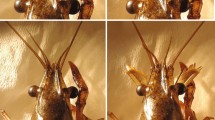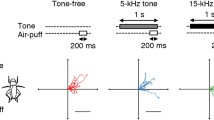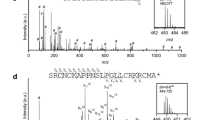Abstract
-
1.
The wasp Ampulex compressa hunts cockroaches as food for her offspring. Stung cockroaches show little spontaneous movement although they are able to move. Wind stimuli to the cerci, which normally produce escape responses, are no longer effective in stung cockroaches. In the present paper, we have searched for neural correlates responsible for the impairment of the escape behavior by the venom.
-
2.
In control cockroaches, a typical motor response in the coxal depressor muscle to wind or tactile stimuli consists of an initial burst of the fast and slow depressor motoneurons followed by rhythmic discharges. In stung cockroaches, both stimuli evoke only a burst in the slow but no discharge activity in the fast depressor neuron. Intracellular recordings from the fast depressor motoneuron in stung cockroaches demonstrate that it still receives synaptic input, though subthreshold, from thoracic interneurons associated with the wind mediated escape circuitry. Discharge activity of the slow motoneuron lacks the rhythmic bursting pattern characteristic for slow walking in control animals.
-
3.
Yet, the venom affects neither the response of descending mechanosensitive giant interneurons to tactile stimuli nor the response of the abdominal giant interneurons to wind stimuli, both of which are known to excite the thoracic interneurons. The venom has also no effect on neuromuscular signal transmission.
Similar content being viewed by others
Abbreviations
- A1-6 :
-
abdominal ganglia 1 to 6
- EMG :
-
electromyogram
- GI :
-
giant interneuron
- TI :
-
thoracic interneuron
References
Beard RL (1952) The toxicology of Habrobracon venom: a study of a natural insecticide. Conn Agric Exp Sta New Haven Bull 562: 1–27
Burdohan JA, Comer CM (1990) An antennal-derived mechanosensory pathway in the cockroach: descending interneurons as a substrate for evasive behavior. Brain Res 535: 347–352
Callec JJ, Sattelle DB (1973) A simple technique for monitoring the synaptic actions of pharmacological agents. J Exp Biol 59: 725–738
Camhi JM (1984) A case study in neuroethology: The escape system of the cockroach. In: Camhi JM (ed) Neuroethology. Sinauer Associates INC, Sunderland Massachusetts, pp 79–105
Camhi JM, Levy A (1989) The code for stimulus direction in a cell assembly in the cockroach. J Comp Physiol A 165: 83–97
Camhi JM, Nolen TG (1981) Properties of the escape system of cockroaches during walking. J Comp Physiol 142: 339–346
Casagrand JL, Ritzmann RE (1992) Biogenic amines modulate synaptic transmission between identified giant interneurons and thoracic interneurons in the escape system of the cockroach. J Neurobiol 23: 644–655
Comer CM, Dowd JP (1993) Multisensory processing for movement: Antennal and cereal mediation of escape turning in the cockroach. In: Beer RD, Ritzmann RE, McKenna T (eds) Biological neural networks in invertebrate neuroethology and robotics. Academic Press Inc, Boston San Diego New York, pp 89–112
Comer CM, Mara E, Murphy KA, Getman M, Mungy MC (1994) Multisensory control of escape in the cockroach Periplaneta americana II. Patterns of touch-evoked behavior. J Comp Physiol A 174: 13–26
Eckert M, Rapus J, Nürnberger A, Penzlin H (1992) A new specific antibody reveals octopamine-like immunoreactivity in cockroach ventral cord. J Comp Neurol 322: 1–15
Eldefrawi AT, Eldefrawi ME, Konno K, Mansour NA, Nakanishi K, Oltz E, Usherwood PNR (1988) Structure and synthesis of a potent glutamate receptor antagonist in wasp venom. Proc Natl Acad Sci USA 85: 4910–4913
Fouad K, Libersat F, Rathmayer W (1994) The venom of the cockroach-hunting wasp Ampulex compressa changes motor thresholds: A novel tool for studying the neural control of arousal? Zoology 98: 23–34
Goldstein RS, Camhi JM (1991). Different effects of the biogenic amines dopamine, serotonin and octopamine on the thoracic and abdominal portions of the escape circuit in the cockroach. J Comp Physiol A 168: 103–112
Huber (1965) Brain controlled behavior in orthopterans. In: Treherne JE, Beament JWL (eds) The physiology of the insect central nervous system. Academic Press, London New York, pp 233–246
Iles JF (1972) Structure and synaptic activation of the fast coxa depressor motoneurone of the cockroach, Periplaneta americana. J Exp Biol 56: 647–656
Kien J, Altman JS (1992) Decision-making in the insect nervous system: a model for selection and maintenance of motor programmes. In: Kien J, McCrohan CR, Winlow W (eds) Neurobiology of motor programme selection. Pergamon Press, Oxford, New York Seoul Tokyo. Pergamon studies in neuroscience No 4, pp 147–169
Libersat F (1992) Modulation of flight by the giant interneurons of the cockroach. J Comp Physiol A 170: 379–392
Liebenthal E, Uhlman O, Camhi JM (1994) Critical parameters of the spike trains in a cell assembly: Coding of turn direction by the giant interneurons of the cockroach. J Comp Physiol A 174: 281–296
Nye SW, Ritzmann RE (1992) Motion analysis of leg joints associated with escape turns of the cockroach, Periplaneta americana. J Comp Physiol A 171: 183–194
Pearson KG, Iles JF (1971) Innervation of coxal depressor muscles in the cockroach, Periplaneta americana. J Exp Biol 54: 215–232
Piek T, Spanjer W (1986) Chemistry and pharmacology of solitary wasp venoms. In: Piek T (ed) Venoms of the Hymenoptera. Academic Press, London, pp 161–308
Piek T, Hue B, Lind A, Mantel P, van Marle J, Vissier JH (1989) The venom of Ampulex compressa -effects on behavior and synaptic transmission of cockroaches. Comp Biochem Physiol 92 C: 175–183
Rathmayer W (1962) Paralysis caused by the digger wasp Philanthus. Nature (Lond) 196: 1148–1151
Rathmayer W (1978) Venoms of Sphecidae, Pompilidae, Mutillidae and Bethylidae. In: Bettini S (ed) Handbook of experimental pharmacology, Vol 48, Arthropod venoms. Springer, Heidelberg, pp 661–690
Ritzmann RE (1993) The neural organization of cockroach escape and its role in context-dependent orientation. In: Beer RD, Ritzmann RE, McKenna T (eds) Biological neural networks in invertebrate neuroethology and robotics. Academic Press Inc, Boston San Diego New York, pp 113–137
Ritzmann RE, Camhi JM (1978) Excitation of leg motor neurons by giant interneurons in the cockroach Periplaneta americana. J Comp Physiol 125: 305–316
Ritzmann RE, Pollack AJ (1986) Identification of thoracic interneurons that mediate giant interneurons-to-motor pathways in the cockroach. J Comp Physiol A 159: 639–654
Ritzmann RE, Pollack AJ (1994) Responses of thoracic interneurons to tactile stimulation in the cockroach, Periplaneta americana. J Neurobiol 25: 1113–1128
Ritzmann RE, Pollack AJ, Tobias ML (1982) Flight activity mediated by intracellular stimulation of dorsal giant interneurons of the cockroach Periplaneta americana. J Comp Physiol 147: 313–322
Ritzmann RE, Pollack AJ, Hudson SE, Hyonen A (1991) Convergence of multi-modal sensory signals at the thoracic interneurons of the escape system of the cockroach, Periplaneta americana. Brain Res 563: 175–183
Roeder KD (1937) The control of tonus and locomotor activity in the praying mantis (Mantis religiosa). J Exp Zool 76: 353–373
Schaefer PL, Kondagunta GV, Ritzmann RE (1994) Motion analysis of escape movements evoked by tactile stimulation in the cockroach, Periplaneta americana. J Exp Biol 190: 287–294
Williams FX (1942) Ampulex compressa (F), a cockroach-hunting wasp introduced from New Caledonia to Hawaii. Proc Haw Ent Soc 11: 221–233
Author information
Authors and Affiliations
Rights and permissions
About this article
Cite this article
Fouad, K., Rathmayer, W. & Libersat, F. Neuromodulation of the escape behavior of the cockroach Periplaneta americana by the venom of the parasitic wasp Ampulex compressa . J Comp Physiol A 178, 91–100 (1996). https://doi.org/10.1007/BF00189593
Accepted:
Issue Date:
DOI: https://doi.org/10.1007/BF00189593




